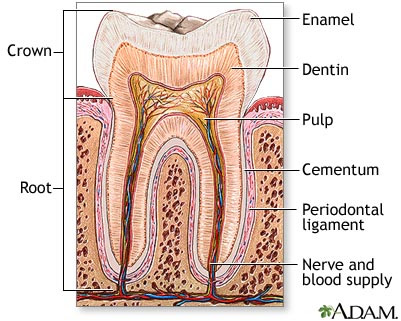Underneath your tooth’s outer enamel and within the dentine is an area of soft tissue called the pulp. This contains the tooth’s nerves, lymph and blood vessels. Root canals are very small, thin divisions that branch off from the top pulp chamber down to the tip of the root. A tooth has at least one but no more than 4 root canals.

Deep tooth decay, deep fractures or an injury due to trauma, can cause serious damage and infection to the pulp. If the pulp becomes infected, the infection can spread through the entire root canal system of the tooth. This will eventually lead to an abscess. If the tooth is left untreated an abscess could spread to the area outside of the tooth, bone around the tooth may degenerate, causing tooth loss.
Once the pulp in infected, the options for treatment are either: Root Canal Treatment or Extraction.
Root canal, or endodontic treatment, cleans out the infected pulp chamber and repairs the damage so the tooth can be saved. Early indication that root canal treatment may be necessary include:
- Increased sensitivity to hot and cool foods
- Severe decay or an injury that creates an abscess (infection) in the bone
- Spontaneous pain or throbbing while biting
Root canal treatment eliminates nerve problems and abscesses and avoids tooth extraction, and is far more cost effective in the long term.
What does it involve?
The aim of the treatment is to remove all infection from the root canal. The root is then cleaned and filled to prevent any further infection. Root canal treatment is a skilled and time-consuming procedure. Most courses of treatment will involve two or more visits to your dentist.
At the first appointment, the infected pulp is removed. Any abscesses, which may be present, can also be drained at this time. The root canal is then cleaned and shaped ready for the filling. A temporary filling is put in and the tooth is left to settle.
The tooth is checked at a later visit and when all the infection has cleared, the tooth is permanently filled.
Frequently Asked Questions
Does it hurt?
No. A local anaesthetic is used and it should feel no different to having an ordinary filling done. We take every care ensuring a comfortable procedure. The majority of people who have undergone root canal treatment typically report that the process itself is no more involved than having a filling placed.
What happens after treatment?
Natural tissue inflammation may cause discomfort for a few days, which can be controlled by an over-the-counter analgesic. A follow-up exam can monitor tissue healing.
What if I don’t have the treatment?
The only alternative is usually extraction of the tooth, which can cause surrounding teeth to shift crookedly, resulting in a bad bite. Though an extraction is cheaper, the space left behind is likely to require an implant or a bridge, which is more expensive and time intensive than root canal therapy. If you have the choice, it's always best to keep your original teeth.
What if it happens again?
More than 90% of root canal treatments are successful. However, if the infection comes back the treatment can be repeated.
What will my tooth look like after treatment?
In the past, a root filled tooth would often darken after treatment. However, with modern techniques this does not usually happen. If there is any discolouration, there are several treatments available to restore the natural appearance.
Will the tooth be safe after treatment?
Yes. However, it is better to restore the tooth with a crown to provide extra support and strength to the tooth.
What about aftercare?
Root-treated teeth should be treated just the same as any other tooth. Remember to clean your teeth twice a day, with a fluoride toothpaste. Cut down on sugary snacks, and keep them only to mealtimes if possible. See your dentist for regular check-ups.
